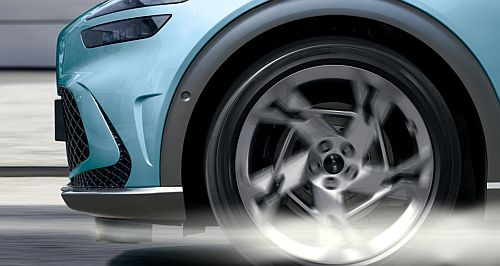Make / Model Search
News - HyundaiHyundai and Kia skirt range anxietyAir skirts to improve range and performance of Hyundai and Kia electric vehicles24 Jan 2024 HYUNDAI Motor Company together with sister company Kia has unveiled technology to help maximise range and performance in their EVs without altering the powertrain.
The tech’ is called an Active Air Skirt (AAS) and is designed specifically for electric vehicles to go further and faster through controlling the turbulence generated during high-speed driving by operating variably depending on the vehicle’s speed.
The AAS is installed between the front bumper and the front wheels and is hidden during normal operation but deploys at speeds over 80km/h when aerodynamic resistance becomes greater than the air resistance. It is stowed automatically once vehicle speed drops below 70km/h.
The system was devised in conjunction with Hyundai and Kia’s E-GMP electric vehicle platform development taking into account the specificity of that platform and is positioned in front of the tyres without completely covering the front end.
The technology improves aerodynamics through increased downforce, which, in turn improves vehicle traction and high-speed stability.
It was validated on the Genesis GV60 with an expected reduction in the drag coefficient of 2.8 per cent thereby improving the driving range.
The AAS system operates on air entering through the lower part of the bumper and effectively controls the turbulence generated around the vehicle’s (often large) wheels.
The air skirt technology was prioritised by Hyundai and Kia as a means of gaining a competitive advantage and through securing a better driving range from a single charge.
Fierce competition on battery range in the EV segment has brought the relationship between vehicles and aerodynamics into sharp focus especially as aerodynamic performance has such a significant impact on performance but also on driving stability and wind noise.
In response, manufacturers are exploring various measures to reduce the coefficient of drag (Cd), which is the resistance coefficient of the air acting in the opposite direction of the vehicle’s motion.
Detail examination of the Hyundai/Kia AAS reveals the drag reducing skirts only cover the front part of the tyres without completely covering the front because they are more effective at improving aerodynamic performance when only covering the tyre part since the E-GMP platform floor is flat.
The system can also operate at speeds over 200km/h thanks to the use of a rubber material on the lower skirt section which reduces the risk of external objects splashing and damaging while driving at high speeds.
Measurements from testing reveal the skirts reduced the drag coefficient (Cd) by 0.008, improving drag by 2.8 per cent as fitted to a test Genesis GV60 which correlates to an additional expected range improvement of about 6km.
“This technology is expected to have a greater effect on models such as SUVs where it is difficult to improve aerodynamic performance,” said Hyundai Motor Group vice president and head of mobility body development group Sun Hyung Cho.
“We will continue to strive to improve the driving performance and stability of electric vehicles through improvements in aerodynamics.”
The system and related parts are under patent application in the US and South Korea.
Hyundai and Kia are using other air shaping technologies to optimise efficiency in their EVs including rear spoilers, active air flaps, wheel air curtains, wheel gap reducers and separation traps.
The Hyundai Ioniq 6, incorporates these technologies and is rated at Cd 0.21.  Read more29th of November 2023  Ioniq 6 discount not sign of failure: HyundaiHyundai defends position of Ioniq 6 BEV despite excess stock, recent $12K price cut |
Click to shareHyundai articlesResearch Hyundai Motor industry news |












Facebook Twitter Instagram